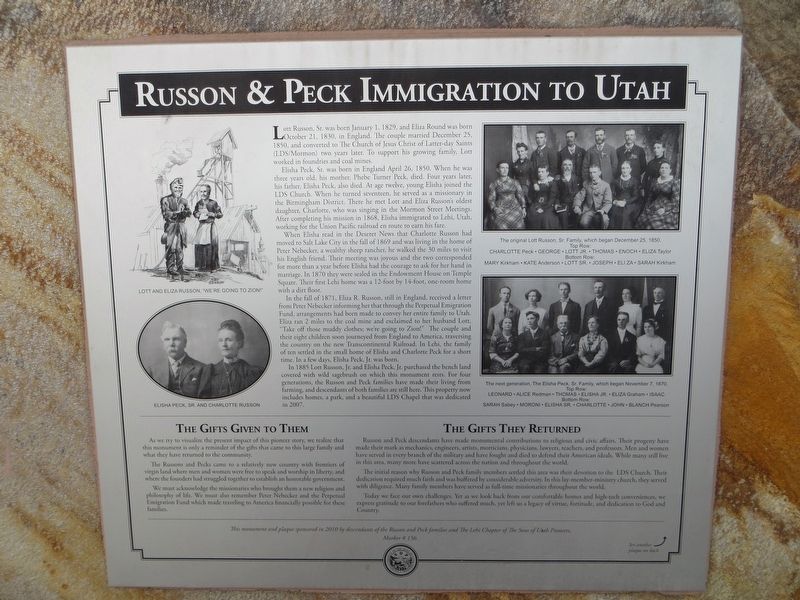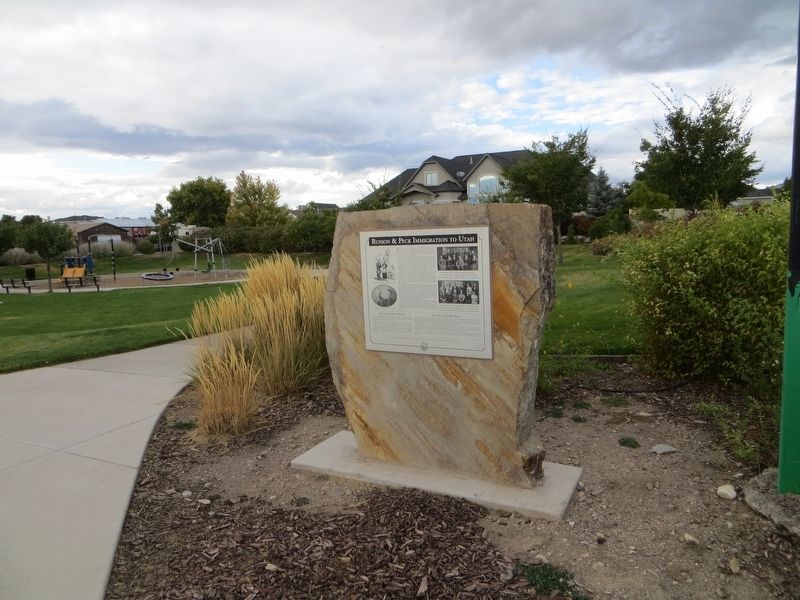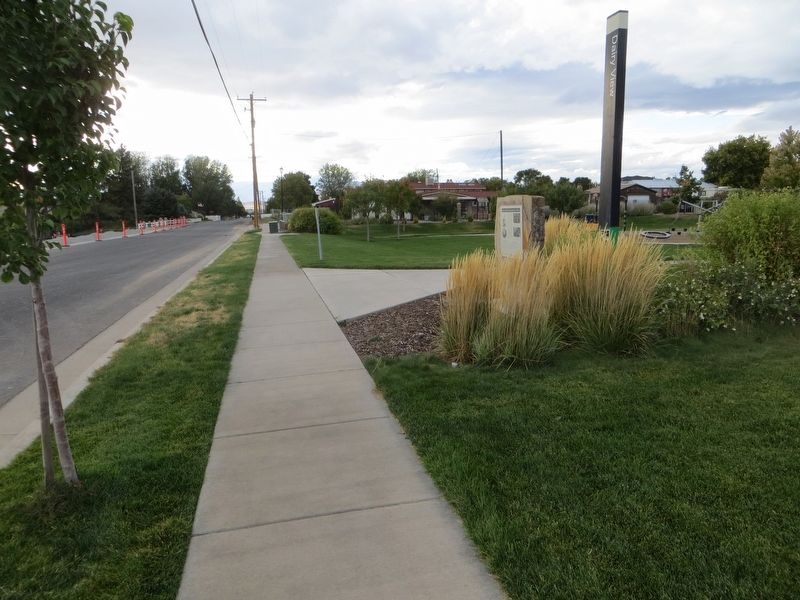Lehi in Utah County, Utah — The American Mountains (Southwest)
Russon & Peck Immigration to Utah
Elisha Peck, Sr. was born in England April 26, 1850. When he was three years old, his mother, Phebe Turner Peck, died. Four years later, his father, Elisha Peck, also died. At age twelve, young Elisha joined the LDS Church. When he turned seventeen, he served as a missionary in the Birmingham District. There he met Lott and Eliza Russon’s oldest daughter, Charlotte, who was singing in the Mormon Street Meetings. After completing his mission in 1868, Elisha immigrated to Lehi, Utah, working for the Union Pacific railroad on route to earn his fare.
When Elisha read in the Deseret News that Charlotte Russon had moved to Salt Lake City in the fall of 1869 and was living in the home of Peter Nebecker, a wealthy sheep rancher, he walked the 30 miles to visit his English friend. Their meeting was joyous and the two corresponded for more than a year before Elisha had the courage to ask for her hand in marriage. In 1870 they were sealed in the Endowment House in Temple Square. Their first Lehi home was a 12-foot by 14-foot, one room home with a dirt floor.
In the fall of 1871, Eliza R. Russon, still in England, received a letter from Peter Nebecker informing her that through the Perpetual Emigration Fund, arrangements had been made to convey her entire family to Utah. Eliza ran 2 miles to the coal mine and exclaimed to her husband Lott, “Take off those muddy clothes; we’re going to Zion!” The couple and their eight children soon journeyed from England to America, traversing the country on the new Transcontinental Railroad. In Lehi, the family of ten settled in the small home of Elisha and Charlotte Peck for a short time. In a few days, Elisha Peck, Jr. was born.
In 1885 Lott Russon, Jr. and Elisha Peck, Jr. purchased the bench land covered with wild sagebrush on which this monument rests. For four generations, the Russon and Peck families have their living from farming, and descendants of both families are still here. This property now includes homes, a park, and a beautiful LDS Chapel that was dedicated in 2007.
The Gifts Given to Them
As we try to visualize the present impact of this pioneer story, we realize that this monument is only a reminder of the gifts that came to this large family and what they have returned to the community.
The Russons and Pecks came to a relatively new country with frontiers of virgin land where men and women were free to speak and worship in liberty, and where the founders had struggled together to establish an honorable government.
We must acknowledge the missionaries who brought them a new religion and philosophy of life. We must also remember Peter Nebecker and the Perpetual Emigration Fund which made traveling to America financially possible for those families.
The Gifts They Returned
Russon and Peck descendants have made monumental contributions to religious and civic affairs. Their progeny have made their mark as mechanics, engineers, artists, morticians, physicians, lawyers, teachers, and professors. Men and women have served in every branch of the military and have fought and died to defend their American ideals. While many still live in this area, many more have scattered across the nation and throughout the world.
The initial reason why Russon and Peck family members settled this area was their devotion to the LDS Church. Their dedication required much faith and was buffered by considerable adversity. In this lay-member-ministry church, they served with diligence. Many family members have served as full-time missionaries throughout the world.
Today we face our own challenges. Yet as we look back from our comfortable homes and high-tech conveniences, we express gratitude to our forefathers who suffered much, yet left us a legacy of virtue, fortitude, and dedication to God and Country.
Erected 2010 by Descendants of the Russon and Peck families and the Lehi Chapter of The Sons of Utah Pioneers. (Marker Number 156.)
Topics and series. This historical marker is listed in this topic list: Settlements & Settlers. In addition, it is included in the Sons of Utah Pioneers series list. A significant historical date for this entry is January 1, 1829.
Location. 40° 23.944′ N, 111° 49.477′ W. Marker is in Lehi, Utah, in Utah County. Marker is on East 900 North west of North 900 West, on the right when traveling west. Touch for map. Marker is in this post office area: Lehi UT 84043, United States of America. Touch for directions.
Other nearby markers. At least 8 other markers are within 2 miles of this marker, measured as the crow flies. Frank H. Eastmond Park (approx. 1.1 miles away); Utah Southern Railroad Depot (approx. 1.1 miles away); Lehi Cemetery (approx. 1.4 miles away); John Austin Cabin (approx. 1˝ miles away); Bishop David Evans (approx. 1˝ miles away); Lehi Memorial Building (approx. 1˝ miles away); The History of the Lehi Sugar Factory (approx. 1˝ miles away); Merrihew/Dalley Building (approx. 1.6 miles away). Touch for a list and map of all markers in Lehi.
Credits. This page was last revised on May 16, 2020. It was originally submitted on May 16, 2020, by Bill Kirchner of Tucson, Arizona. This page has been viewed 345 times since then and 71 times this year. Photos: 1, 2, 3. submitted on May 16, 2020, by Bill Kirchner of Tucson, Arizona.


